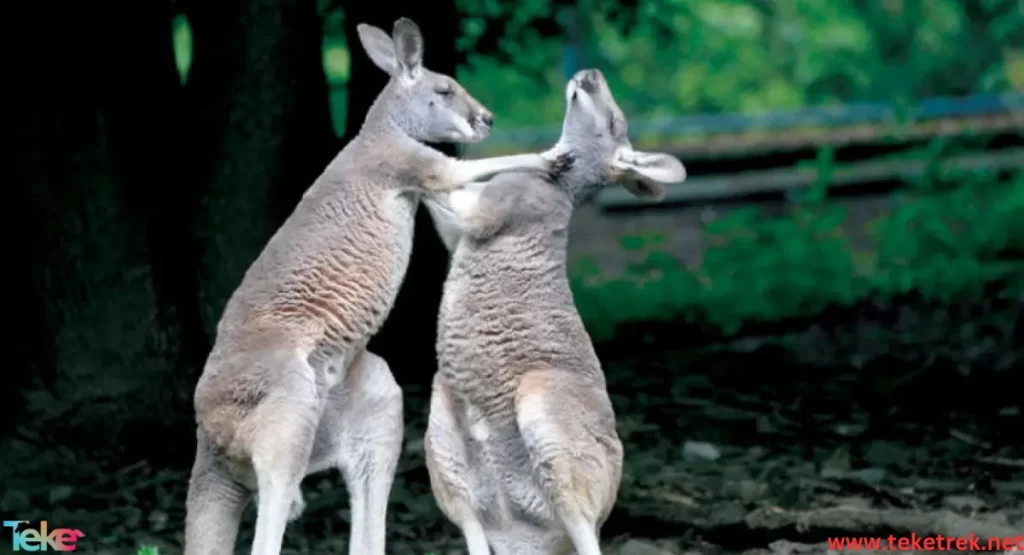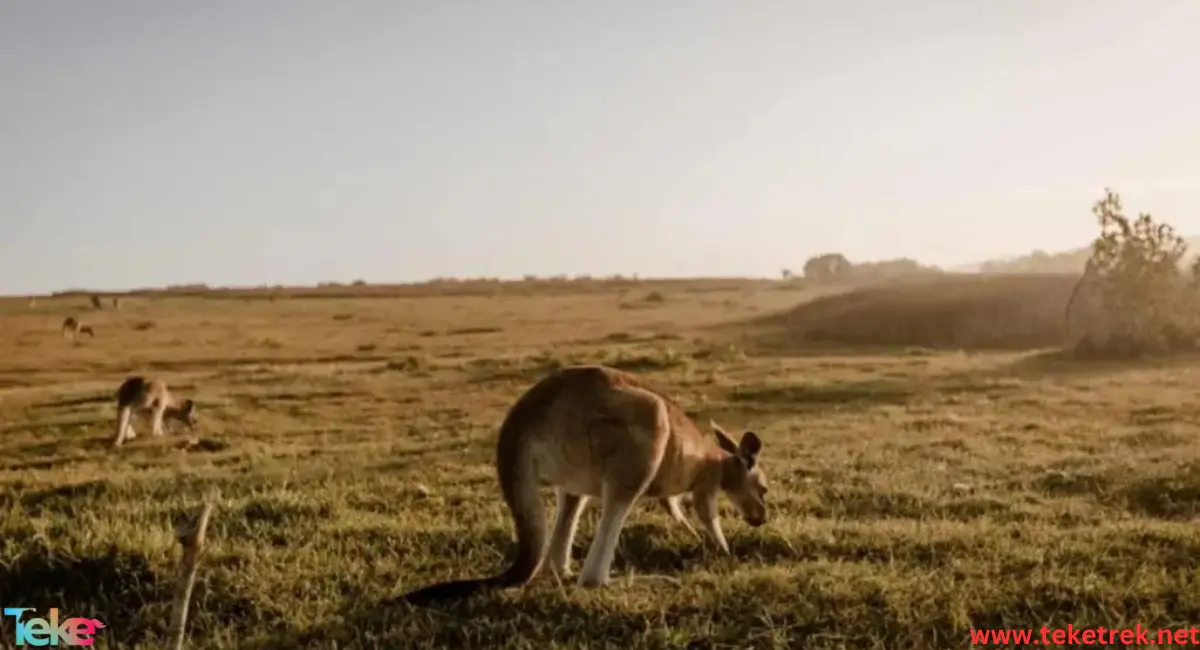The kangaroo is a marsupial native to the continent of Australia. Its most distinctive features are its large hind legs, long feet, and large tail.
Kangaroos are considered unique animals because they are the only animals of their size that use hopping as their primary means of movement. These creatures are beloved by humans, especially children, and they have a unique lifestyle and behavior.
In this article, we will explore the kangaroo, its reproductive methods, habitat, and diet.
Kangaroo specifications
- The kangaroo possesses two powerful hind legs that enable it to hop quickly, utilizing the strength of its strong leg muscles.
- It has a long tail that it uses for balance while hopping and for support when sitting.
- Females have a permanent pouch, called the marsupium, which serves various functions. It contains the female kangaroo’s mammary glands used to nurse her young inside the pouch. The pouch also acts similarly to an incubator, allowing the joey (baby kangaroo) to fully develop.
- Additionally, the pouch serves a protective function, helping to shield the female’s young from predators.

- Kangaroos are capable of leaping distances of up to 9 meters in horizontal flight and reaching heights of up to 3 meters. They can also move at speeds of up to 56 kilometers per hour.
- Kangaroo sizes vary between species, with larger kangaroos reaching heights ranging from 1.5 to 2 meters, while smaller kangaroos are much smaller. Kangaroo weigh more than 200 pounds.
- The kangaroo has a relatively small head compared to its body size, with two large ears that help it sense sounds in the surrounding environment.
- Kangaroos are characterized by short, dense fur that protects from harsh environmental conditions, with fur colors ranging from gray, and brown, to black.
- Kangaroos can live for a long period of up to 20 years in the wild.
Locations of kangaroos
- The kangaroo inhabits Australia, Tasmania, and the surrounding islands in a variety of habitats, including forests, grasslands, and savannas. Depending on the species, kangaroos occupy different niches within the ecosystem.
Kangaroo food and behavior
- The kangaroo is a herbivorous animal, primarily feeding on a variety of plants such as grasses, shrubs, and flowers. Some may also eat fungi and algae.
- Kangaroos live in groups known as mobs, led by a dominant male.
- Similar to cows, kangaroos may regurgitate their food to chew it as cud before swallowing it again. However, this behavior is much less common in kangaroos compared to ruminant animals.
- The kangaroo’s stomach differs from that of cows and similar animals. While both kangaroos and cows have a chambered stomach, the fermentation process in each of them is different. Unlike cows, kangaroos produce much less methane gas during this process, so they do not contribute significantly to global methane emissions like cattle do.
- Kangaroos are typically active during the night and early morning hours, although their activity patterns vary. Their rest periods are almost exclusively during the daytime.
- Similar to camels, they may go for extended periods without drinking water due to their relatively low activity during the day when temperatures are higher. Because their diet consists of plants, their water needs can largely be met through the water content in the plants they consume.
Reproduction and offspring
- The kangaroo has a varied breeding season. Breeding occurs throughout the year, but the Australian summer months from December to February are the most common.
- Male kangaroos may flex their muscles to attract females and may fight for mating rights with females.
- Females usually put birth to one young.
- After pregnancy, the kangaroo gives birth to its offspring after a gestation period of slightly over a month (about 36 days).
- The joey weighs approximately 0.8 grams and is less than an inch long at birth, about the size of a grape.
- After birth, the joey uses its front limbs to crawl through its mother’s fur into her pouch, where it will remain for the first few months of its life.
- Between five to nine months, depending on the species, joeys typically leave the pouch for short periods.
- After about nine to eleven months, the joey leaves its mother’s pouch for good.
- Female kangaroos can become pregnant again while still nursing their joey in the pouch.
- The weaned joey remains in a state of torpor that coincides with its older sibling leaving the mother’s pouch.
- When the older sibling leaves the pouch, the mother’s body sends hormonal signals to the torpid joey to resume its growth. A similar process occurs if the mother is pregnant and her older offspring dies in her pouch.
Kangaroo numbers and risk of extinction
- Kangaroos have been classified as the least concern by the International Union for Conservation of Nature (IUCN). The population of kangaroos is very abundant, and according to most estimates, there are more kangaroos in Australia than there are people. Estimates range from 40 to 50 million kangaroos, and this number continues to increase.
- Humans pose the primary threat to kangaroos, as they are hunted for their meat and hides. The main threat to kangaroos is humans, who hunt them for their meat and skins, or habitat loss as they clear land for development. Predators such as dingoes and foxes also pose threats. Kangaroos use their teeth, claws and powerful hind legs as defense mechanisms against such predators. Predators such as dingoes and foxes also pose threats. Kangaroos use their teeth, claws, and strong hind legs as defense mechanisms against such predators.


Species of kangaroos
There are four main species of kangaroos:
1. Red Kangaroo: Considered the largest species of kangaroo in terms of size, it is the national emblem of Australia. Males of this species have red/brown fur.
2. Eastern Grey Kangaroo: The second-largest species of kangaroo, found in eastern Australia.
3. Western Grey Kangaroo (Macropus fuliginosus): Also known as the Black-faced Kangaroo due to its distinctive facial coloration.
4. Some scientists believe there are six species of kangaroos, including Macropus Robustus and Macropus Bernardus. Wallaroos are closely related to both kangaroos and wallabies.
Conclusion
Humans and kangaroos have had a long and diverse interaction pattern with each other. Humans have used kangaroos for food, clothing, and some types of shelter for a long time. Due to their increasing numbers, kangaroos can be considered pests, especially by farmers when kangaroos compete for grazing lands. Kangaroos are often found in grasslands and areas that are typical agricultural lands, leading to competition for resources.






